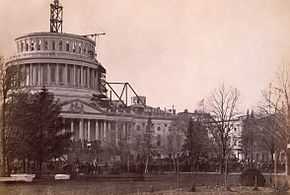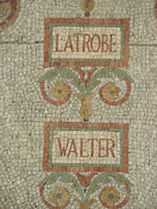Thomas Ustick Walter
| Thomas Ustick Walter | |
|---|---|
 Thomas U. Walter | |
| Born |
September 4, 1804 Philadelphia, Pennsylvania |
| Died | October 30, 1887 (aged 83) |
| Nationality | American |
| Buildings | Moyamensing Prison, Girard College |
| Projects | United States Capitol dome, Philadelphia City Hall |
Thomas Ustick Walter (September 4, 1804 – October 30, 1887), born Philadelphia, Pennsylvania, was an American architect, the dean of American architecture between the 1820 death of Benjamin Latrobe and the emergence of H.H. Richardson in the 1870s. He was the fourth Architect of the Capitol, responsible for adding the north (Senate) and south (House) wings and the central dome that brought the U.S. Capitol building to essentially its modern appearance. Walter was one of the founders and second president of the American Institute of Architects.
Early life
Born in 1804 in Philadelphia, Walter was the son of mason and bricklayer Joseph S. Walter and his wife Deborah.[1]
Walter received early training in a variety of fields including masonry, mathematics, physical science, and the fine arts. At 15, Walter entered the office of William Strickland, studying architecture and mechanical drawing,[1] then established his own practice in 1830.[2]
Works

Walter's first major commission was Moyamensing Prison, the Philadelphia County Prison. Designed as a humane model in its time, the prison was built between 1832 and 1835.[2]
He first came to national recognition for his design of Girard College for Orphans (1833–48) in Philadelphia, among the last and grandest expressions of the Greek Revival movement.
Walter also designed mansions, banks, churches, the hotel at Brandywine Springs, and courthouses.[3] In 1836, he designed the Bank of Chester County at West Chester, Pennsylvania;[4] a decade later, he designed the 1846 Chester County Courthouse in Greek Revival style.[5] In Lexington, Virginia, he designed the Lexington Presbyterian Church in 1843.[6] In Norfolk, Virginia, he designed the Norfolk Academy in 1840.[7] The Tabb Street Presbyterian Church was erected at Petersburg, Virginia in 1843.[8]
It has also been suggested that Walter designed the Second Empire-styled Quarters B and Quarters D at Admiral's Row in Brooklyn, New York.
Among the notable residences designed by Walter were his own home, located at High and Morton Streets in Germantown, Philadelphia, Pennsylvania, the Nicholas Biddle estate Andalusia (estate), Inglewood Cottage, and St. George's Hall, residence of Matthew Newkirk, president of the Philadelphia, Wilmington & Baltimore Railroad.[9] Walter also designed the Garrett-Dunn House in Mt. Airy, Philadelphia, Pennsylvania, which was destroyed by fire after being struck by lightning on August 2, 2009.
The U.S. Capitol and its dome

By far the most famous construction of Walter's is the dome of the U.S. Capitol. By 1850, the rapid expansion of the United States had caused a space shortage in the Capitol. Walter was selected to design extensions for the Capitol. His plan more than doubled the size of the existing building and added the familiar cast-iron dome.
There were at least six draftsmen in Walter's office, headed by Walter's chief assistant, August Schoenborn, a German immigrant who had learned his profession from the ground up. It appears that he was responsible for some of the fundamental ideas in the Capitol structure. These included the curved arch ribs and an ingenious arrangement used to cantilever the base of the columns. This made it appear that the diameter of the base exceeded the actual diameter of the foundation, thereby enlarging the proportions of the total structure.[10]

Construction on the wings began in 1851 and proceeded rapidly; the House of Representatives met in its new quarters in December 1857 and the Senate occupied its new chamber by January 1859. Walter's fireproof cast iron dome was authorized by Congress on March 3, 1855, and was nearly completed by December 2, 1863, when the Statue of Freedom was placed on top. He also reconstructed the interior of the west center building for the Library of Congress after the fire of 1851. Walter continued as Capitol architect until 1865, when he resigned his position over a minor contract dispute. After 14 years in Washington, he retired to his native Philadelphia.
Then, when financial setbacks forced him to come out of retirement in the 1870s, he worked as second-in-command when his friend and younger colleague John McArthur, Jr. won the competition for Philadelphia City Hall. He continued on that vast project until his death in 1887.
Other Honors
For their architectural accomplishments, both Benjamin Latrobe and Thomas U. Walter are honored in a ceiling mosaic in the East Mosaic Corridor at the entrance to the Main Reading Room of the Library of Congress.
Walter's grandson, Thomas Ustick Walter III, was also an architect, practicing in Birmingham, Alabama from the 1890s to the 1910s.[11]
Gallery
-

Moyamensing Prison, completed 1835
-
One of Walter's first commissions, the First Presbyterian Church, West Chester, Pennsylvania, built 1832.
-
Chester County Courthouse in West Chester.
-
First Baptist Church, Bristol, Pennsylvania
-
Mosaic in ceiling of Library of Congress, Washington, DC honoring Benjamin Henry Latrobe and Thomas Walter
-
Mosaic detail
-
Tabb Street Presbyterian Church, December 2009
See also
- Old Patent Office Building
- 1877 U. S. Patent Office fire
References
| Wikimedia Commons has media related to Thomas U. Walter. |
- ↑ 1.0 1.1 Frary, Ihna Thayer (1940). They Built the Capitol. Ayer Publishing. p. 201.
- ↑ 2.0 2.1 Mason, Jr., George C. (1888). "Memoir". Proceedings of the ... annual convention of the American Institute of Architects. 21-22: 101–108.
- ↑ http://www.philaathenaeum.org/tuw/
- ↑ "Bank of Chester County, 17 North High Street, West Chester, Chester County, PA" (Searchable database). Library of Congress, Historic American Buildings Survey, Engineering Record, Landscapes Survey Collection. Retrieved 2012-11-12.
- ↑ dsf.chesco.org - Chester county courthouse West Chester, Pennsylvania
- ↑ Virginia Historic Landmarks Commission Staff (March 1978). "National Register of Historic Places Inventory/Nomination: Lexington Presbyterian Church". Virginia Department of Historic Resources.
- ↑ Virginia Historic Landmarks Commission Staff (July 1969). "National Register of Historic Places Inventory/Nomination: Norfolk Academy". Virginia Department of Historic Resources. and Accompanying photo
- ↑ Virginia Historic Landmarks Commission Staff (February 1978). "National Register of Historic Places Inventory/Nomination: Tabb Street Presbyterian Church". Virginia Department of Historic Resources.
- ↑ "St. George’s Hall. [graphic]". The Library Company of Philadelphia. Retrieved 2011-06-18.
- ↑ August Schoenborn at the archINFORM database
- ↑ Fazio, Michael W. (2010) Landscape of Transformations: Architecture and Birmingham, Alabama. Knoxville, Tennessee: University of Tennessee Press ISBN 978-1-57233-687-2
External links
- http://www.aoc.gov/AOC/walter.htm
- Brief biography of Thomas Ustick Walter
- Walter's drawings at the Atheneum of Philadelphia
- The Winterthur Library Overview of an archival collection on Thomas Ustick Walter.
- Library of Congress, Jefferson Building East Corridor mosaics
- Old Patent Office Building video
|





